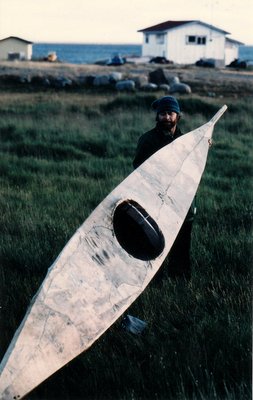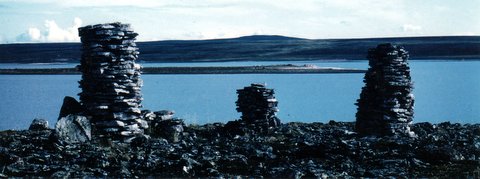by Mark Taylor


Kayaks were an important tool in the fall caribou hunt which provided the major food supply for the Keewatin Inuit, not to mention the value or skins, bones and antlers. Across the major rivers and lakes are routes the caribou use, though they are not predictable and the caribou say use a particular crossing only every few years. Caribou detour around the largest lakes and are therefore funneled through certain areas which become preferred hunting spots. The Inuit would paddle up the Thelon or Kazan Rivers in the late summer to well known caribou crossing places and wait. Usually many caribou would be killed, far more than could be carried back in one trip, and so the animals would be butchered and the meat stored in country caches. These caches were built of large stones and would each hold several butchered caribou. We came across one old settlement area at the east end of Aberdeen Lake with numerous caches, and when we lifted the lids on some of them were surprised to find large numbers of caribou bones; obviously the hunters who had stored the meat never returned to pick it up.
Not far away from the food caches was an old grave, complete with a wooden cross as a grim reminder that often the hunts did not turn out well. In fact, it was back in the 1950s that many Inuit in the Keewatin died from starvation because the caribou never came to the crossings where the hunters waited. It was after this event that the federal government relocated family bands into a number of settlements like Baker Lake and Chesterfield Inlet, so that at least the basic necessities of life could be provided for by the government.
We came across evidence of old camps by several lakes in the interior, but the encampment at the end of Aberdeen Lake was particularly large. In addition to the food caches there are the ruins of many summer homes and inukshuks. The summer homes were tents weighed down with large stones in a ring with an opening looking out across the lake. The inukshuks, the tallest at Aberdeen over two and a half metres tall, are visible from a considerable distance and served as sign posts to the people.
The Inuit also used their kayaks for traveling considerable distances for trading, and on long trips the skins would become water logged and have to be dried out. During one of my walks near Judge Sissons Lake I was shown by Alex, my Inuit guide, three large stones standing upright. He told me that they were used for resting a kayak on so that it could dry out. Alex also explained that they had special places to store the kayaks through the winter. I had not thought about it, but obviously a kayak would not fit into an igloo and one does not want someone inadvertently stepping through the snow onto one’s kayak. So they built rock shelters into which they placed their boats, covering the top with big flat rocks.

Today the Inuit still hunt caribou, but utilize high powered rifles, snowmobiles and power boats. As a result, the traditional kayak is a thing of the past, a relic of previous generations. I felt very privileged to be able to look a little bit into the past and see how they traveled. I hope very much for their future as they adapt to a modern world, and I just hope that the caribou, musk-ox and grizzlies make it into the next century as well.
This article originally appeared in the Spring 1992 (Vol. 4, No. 1) issue of Qayaq. It is another in a series of articles from our first quarter century that we are reprinting as GLSKA marks its 25th anniversary.
